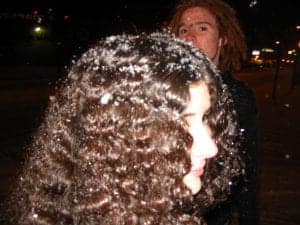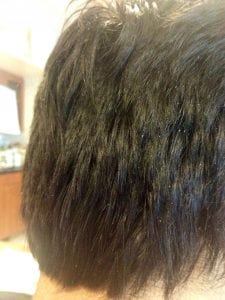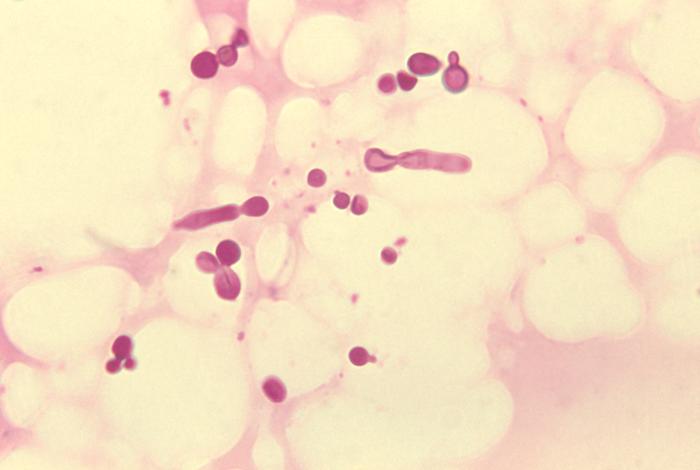Is Dandruff – Seborrheic Dermatitis, A Cause of Hair Loss and Poor Hair Transplant Outcomes: Hair transplant patients who suffer seborrheic dermatitis on the scalp (commonly known as dandruff) are likely to face a higher risk of compromised graft survival following their procedure. This issue, however, tends to be severely overlooked since dandruff flakes appear on the surface of the scalp. In a hair transplant surgery, hair follicle grafts are transplanted much deeper, about 3-4 mm below in the deeper part of the dermis layer. However, this does not mean they are immune to the potential damage that can be caused by having a dandruff condition. Dr.U explains that dandruff is an unrecognized spoiler of hair transplant results. Specialized attention must then be given to patients who are prone to experiencing symptomatic flaking and itchiness of the scalp.
How Can Dandruff or Seborrheic Dermatitis Cause Hair Loss?

Dandruff manifests clinically as a flaky scalp. Sufferers are often embarrassed by the white scaly flakes that deposit on their eyebrows, facial hair, but most prominently on their dark clothes! But most significant to hair loss is what happens at the scalp level. On closer examination, flaky areas often exhibit mild to moderate redness which is a sign of inflammation. Alternatively, the redness might be completely absent in a phenomenon called “sub-clinical seborrheic dermatitis.” In all instances, flaking with or without redness is indicative of some inflammatory reaction in the affected scalp area. Inflammation is further confirmed by histologic findings of scalp biopsies of dandruff patients. Specific histologic findings in seborrhoeic dermatitis include superficial perivascular and perifollicular inflammatory infiltrates, psoriasiform hyperplasia, and parakeratosis around follicular openings [1]. Inflammation of the scalp creates a stressful environment for hair to survive. One should think of hair loss as a product of the relationship between the hair follicles and the scalp. In other words, the scalp provides an “incubatory environment” for the emerging hair shaft. Thus the optimal condition of the scalp would then serve to support the health of the follicle and the production of hair. And likewise, suboptimal scalp environments would be detrimental to hair survival and growth. Inflammation is a sub-optimal scalp environment that is detrimental to hair survival.

According to Dr.U, the Malessezia yeast is a prominent microorganism residing on the scalp in each and every one of us. But we differ, on an individual basis in terms of how much of the yeast is present, and secondly, the way we respond to it. As discussed, much higher populations can arise due to elevated rich sebum levels, as induced by greater than average androgen concentrations in the blood. This, of course, induces the onset of inflammatory responses to the detriment of the hair follicles. The other type of abnormality which leads to problematic circumstances for the hair has to do with the extent to which a person’s immune system responds to the presence of the Malessezia yeast. In some people, this is a greater and more amplified reaction compared to other individuals. Dr. U further supports his assertion by pointing to further direct evidence of how seborrheic dermatitis creates a hostile milieu for the hair follicles that would result in loss of hair. Studies have detected Malassezia on the scalp of dandruff patients [2,3], and higher numbers of Malassezia (M. globosa and M. restricta) correlate with SD appearance/severity [4,5,6]. Additionally, among the multiple chemical entities that are effective in treating SD and dandruff, such as azoles, hydroxypyridones, allylamines, selenium, and zinc, the sole common mechanism of action is antifungal activity [7–5]. Furthermore, Malassezia was shown to have lipase activity, which hydrolyzes human sebum triglycerides and releases unsaturated fatty acids such as oleic and arachidonic acid [8,9]. These metabolites cause aberrant keratinocytes differentiation, resulting in stratum corneum abnormalities such as parakeratosis, intracellular lipid droplets, and irregular corneocyte envelope [10]. Such changes lead to the disrupted epidermal barrier function and trigger an inflammatory response, with or without visible local inflammation. In addition, these metabolites induce keratinocytes to produce pro-inflammatory cytokines such as IL-1α, IL-6, IL-8, and TNF-α, thus prolonging the inflammatory response [11,12]. Considering that both IL-1α [13] and IL-6 [14] have both been associated with induction of Anagen to catagen degenerative changes in the hair cycle and TNF-α [13] has been associated with causing apoptotic changes in catagen, it becomes very evident why dandruff or seborrheic dermatitis causes, precipitate or aggravate hair loss. It has been known that DHT (the cause of androgenetic alopecia) causes hair loss by up-regulating IL-6 and TNF activity [14].

Will Dandruff Affect Your Hair Transplant Outcome?
Although there are various treatments for dandruff, individuals who are considering a hair transplant must still take their condition into serious account when deciding to undergo surgery. Failing to do so is likely to become dangerous for the survival and integrity of the implanted grafts.
As a board-certified dermatologist, Dr. U also notes that dandruff is a chronic and persistent condition that remains pervasive throughout an individual’s lifetime. It cannot be cured or eradicated. Shampoos, products, and various forms of treatment can minimize the appearance of flakes. But seborrheic dermatitis does not actually go away.
As discussed above, different physiological conditions remain constant. This is due to our genetics which dictates how much androgen we produce or how we react to normal counts of Malessezia yeast etc. These factors are what sustain a person’s dandruff condition for life.
A hair transplant, which only transfers hair follicles from one location to another, will not change the relationship between the nature and behavior of a person’s physiology and the Malessezia yeast. Oxidative damage and inflammation will still occur, presenting a dire threat for the newly inserted grafts which are especially vulnerable in the early stages when the primordial hair stem cells and tissues require a supportive tissue milieu to incubate. Read previous paragraphs on the direct relationship between dandruff also called seborrheic dermatitis and hair loss.
Before You Get A Hair Transplant, Find Out What to Do About Your Seborrheic Dermatitis
The individual differences and variability which underlie seborrheic dermatitis ( aka Dandruff) necessitate a specialized and differential approach to treating each case, rather than a generic one-size-fits-all solution. If you have dandruff and are contemplating a hair transplant, be aware that if your dandruff is not addressed aggressively, your hair transplant results could be negatively impacted. Additionally, the wrong treatment may compromise your result as well. At the Dr.U Hair and Skin Clinics in Los Angeles, we have taken this issue into consideration offer our patients uniquely tailored anti-dandruff regimens for the post-surgery care of our patients, based on a more precise medical understanding of their physiology,
Intervention would include, but is not limited to, one or more of the following:
- steroids
- topical treatments including selenium sulfide, Ketoconazole, etc
- light therapy
- tar shampoo
- salicylate shampoo
- Calcipotriene
If a patient is not responsive to a single approach, a combination of different treatment types and modalities would be a more appropriate option. Also key to management is the timing and choreographing of the various treatment regimens in the context of different timelines post hair transplant surgery. As a board-certified dermatologist specializing in the management of hair and skin diseases, Dr. U frequently customizes seborrheic dermatitis management specific to the hair transplant patient’s requirements.

Customized treatment plans are the way to go for managing dandruff after a hair transplant procedure, and even beyond
Not Opting for Hair Transplantation Just Yet? Why Using Minoxidil When You Have Dandruff Is Still A Bad Idea
Even individuals with seborrheic dermatitis who decide to use Minoxidil to manage their hair loss, whether they choose the route of hair transplantation or not, must be aware of the fact that this commonly recommended treatment becomes risky for their hair follicles. So why would this be the case?
Dr.U points out that the alcohol and propylene glycol content of the medication can aggravate dandruff flaking, making it much worse. And more severe consequences may arise in those who are allergic to Minoxidil.
Since dandruff is a very common skin condition, generally known to be treated with shampoos, it has been regarded as being a less serious concern. However, many people are unaware that it’s overall dynamic is not just restricted to the visible flaking of the skin’s surface. It is a condition that more deeply affects the scalp’s biome and the overall environment in which the hair follicles reside. Hair transplant patients, and even more so, anyone who struggles with dandruff must pay closer attention to the broader picture of risks that can lead to damaged follicles and subsequent hair loss.
Whether you are in the general Los Angeles area or another part of the world, Dr.U offers free online consultations to answer your questions about hair transplant surgery as well as issues like dandruff. Click the button below to submit your inquiry.
References
- https://dermnetnz.org/topics/seborrhoeic-dermatitis/
- Rudramurthy SM, Honnavar P, Dogra S, Yegneswaran PP, Handa S, et al. Association of Malassezia species with dandruff. Indian J Med Res. 2014;139:431–437.
- DeAngelis YM, Gemmer CM, Kaczvinsky JR, Kenneally DC, Schwartz JR, et al. Three etiologic facets of dandruff and seborrheic dermatitis: Malassezia fungi, sebaceous lipids, and individual sensitivity. J Investig Dermatol Symp Proc. 2005;10:295–297.
- Schwartz RA, Janusz CA, Janniger CK. Seborrheic dermatitis: an overview. Am Fam Physician. 2006;74:125–130.
- Heng MC, Henderson CL, Barker DC, Haberfelde G. Correlation of Pityosporum ovale density with clinical severity of seborrheic dermatitis as assessed by a simplified technique. J Am Acad Dermatol. 1990;23:82–86.
- McGinley KJ, Leyden JJ, Marples RR, Kligman AM. Quantitative microbiology of the scalp in non-dandruff, dandruff, and seborrheic dermatitis. J Invest Dermatol. 1975;64:401–405.
- Berk T, Scheinfeld N. Seborrheic dermatitis. P T. 2010;35:348–352.
- DeAngelis YM, Saunders CW, Johnstone KR, Reeder NL, Coleman CG, et al. Isolation and expression of a Malassezia globosa lipase gene, LIP1. J Invest Dermatol. 2007;127:2138–2146.
- Plotkin LI, Squiquera L, Mathov I, Galimberti R, Leoni J. Characterization of the lipase activity of Malassezia furfur. J Med Vet Mycol. 1996;34:43–48.
- Warner RR, Schwartz JR, Boissy Y, Dawson TL., Jr Dandruff has an altered stratum corneum ultrastructure that is improved with zinc pyrithione shampoo. J Am Acad Dermatol. 2001;45:897–903.
- Schwartz JR, Messenger AG, Tosti A, Todd G, Hordinsky M, et al. A comprehensive pathophysiology of dandruff and seborrheic dermatitis – towards a more precise definition of scalp health. Acta Derm Venereol. 2013;93:131–137.
- Faergemann J, Bergbrant IM, Dohse M, Scott A, Westgate G. Seborrhoeic dermatitis and Pityrosporum (Malassezia) folliculitis: characterization of inflammatory cells and mediators in the skin by immunohistochemistry. Br J Dermatol. 2001;144:549–556.
- Hoffmann R1, Happle R, Paus R. Elements of the interleukin-1 signaling system show hair cycle-dependent gene expression in murine skin. 1996 Mar;288(3):153-6.
- Kwack MH1, Ahn JS, Kim MK, Kim JC, Sung YK.Dihydrotestosterone enhances transforming growth factor-beta-induced apoptosis in hormone-sensitive prostate cancer cells. 2012 Jan;132(1):43-9. doi: 10.1038/jid.2011.274. Epub 2011 Sep 1.
Frequently Asked Questions – Dandruff and Hair Transplantation
1. Why do some hair transplant patients find that dandruff shampoos don’t work, even if they are recommended by their doctor?
According to Dr.U, if the recommended shampoo is not effective, it should be escalated to other possible options such as the use of steroids or other treatment that a qualified dermatologist can choose such as light therapy, tar, or an antipsoriatic regimen. Also, the ineffectiveness of shampoos may be due to an inaccurate diagnosis which should then be revisited. It may also be the case that there is a perpetuating condition that needs to be addressed, such as the presence of an irritant found in hair products or even the usage of topical minoxidil in some instances.
2. Should I be considered about hair loss after my hair transplant if I have very mild occurrences of dandruff flaking
Even in mild cases, there is still the potential risk of inflammation in response to the microorganisms causing your symptoms. This can be detrimental for your new grafts
3. Do I need to continue my anti-dandruff regimen after all my hair transplant grafts have grown in?
Yes, by all means. Although the degree of dandruff flaking can be managed to the point where it is not a highly visible concern, the inflammation due to your immune system’s response to your scalp’s yeast is really the underlying risk that can affect your new grafts as well as your native hair.
Further Reading
Reason for poor growth after a hair transplant
Learn more about how environmental factors can work together with genes to contribute to hair loss
